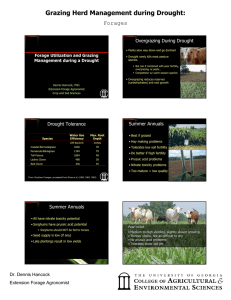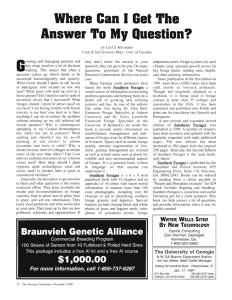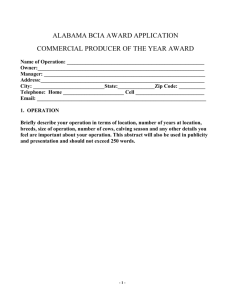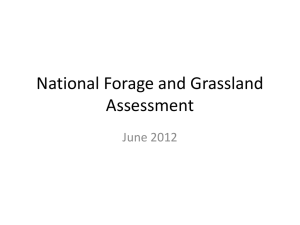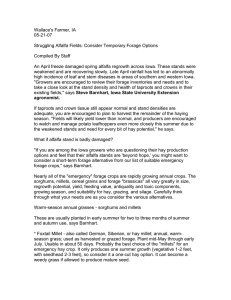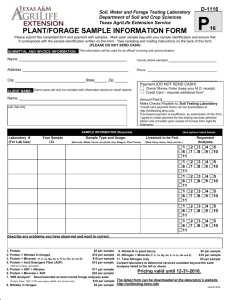Grazing Herd Management during Drought: Forages A few assumptions…
advertisement
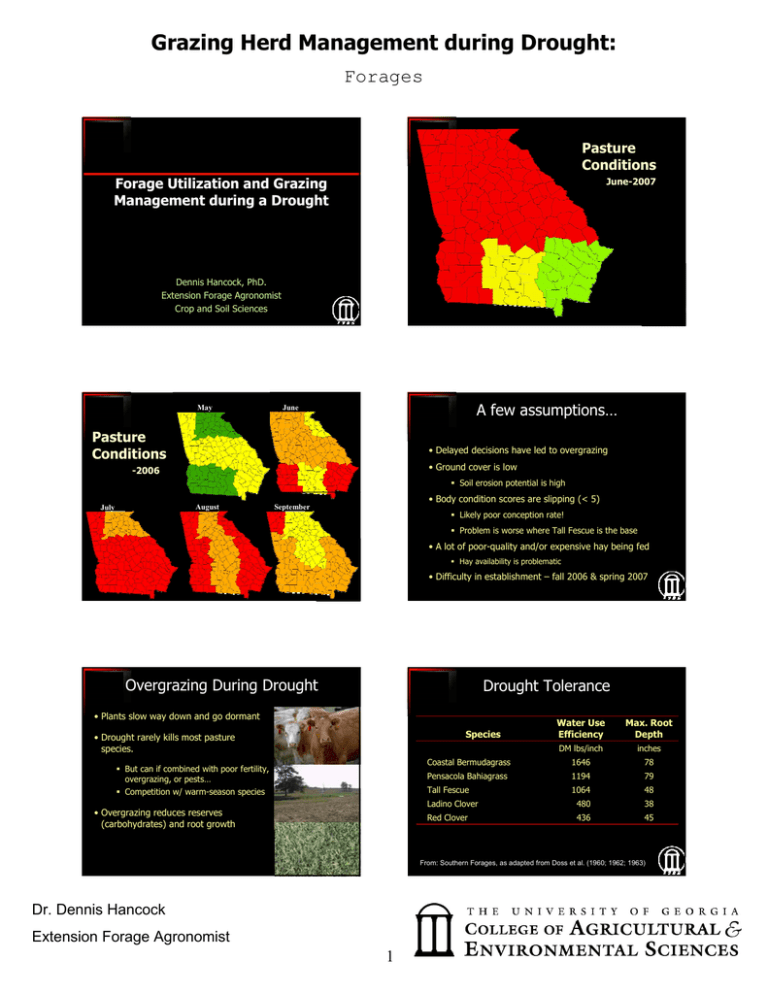
Grazing Herd Management during Drought: Forages Pasture Conditions Forage Utilization and Grazing Management during a Drought June-2007 Dennis Hancock, PhD. Extension Forage Agronomist Crop and Soil Sciences May A few assumptions… June Pasture Conditions • Delayed decisions have led to overgrazing • Ground cover is low -2006 Soil erosion potential is high • Body condition scores are slipping (< 5) August July September Likely poor conception rate! Problem is worse where Tall Fescue is the base • A lot of poor-quality and/or expensive hay being fed Hay availability is problematic • Difficulty in establishment – fall 2006 & spring 2007 Overgrazing During Drought Drought Tolerance • Plants slow way down and go dormant Species • Drought rarely kills most pasture species. But can if combined with poor fertility, overgrazing, or pests… Competition w/ warm-season species • Overgrazing reduces reserves (carbohydrates) and root growth Water Use Efficiency Max. Root Depth DM lbs/inch inches Coastal Bermudagrass 1646 78 Pensacola Bahiagrass 1194 79 Tall Fescue 1064 48 Ladino Clover 480 38 Red Clover 436 45 From: Southern Forages, as adapted from Doss et al. (1960; 1962; 1963) Dr. Dennis Hancock Extension Forage Agronomist 1 Grazing Herd Management during Drought: Forages Summer Annuals • Best if grazed • Hay making problems Pearl millet • Medium to high yielding, slightly slower growing • Thinner stems, not as difficult to dry • No prussic acid problems • Tolerates lower soil pH • Seed supply is low • Tolerates low soil fertility • Do better if high fertility • Prussic acid problems • Nitrate toxicity problems • Too mature = low quality Summer Annuals Summer Annuals Sorghum species • Forage sorghum All have prussic acid and nitrate toxic potential NOT for horses! Less drought tolerant than pearl millet High yielding, fast growing Thick stems, difficult to dry for hay • Sudangrass Medium yielding, fast growing Thinner stems, difficult to dry for hay • Sorghum x sudan hybrids High yielding, fast growing Still have thick stems and difficult to hay Summer Annual Establishment Summer Annual Fertilization • Plant anytime after April 15th • 60 - 80 lbs of actual N/ac at planting Plan on 3 harvests per year • 60 - 80 lbs N/ac after each harvest Later plantings = few harvests • Requires significant P and K • Seeding Follow soil test recommendations Seed can be broadcast or K is really important under drought conditions Planted in rows - narrow (< 15 in.) or wide (< 36 in.) • Pearl millet is less sensitive to low soil pH Planting depth of ½ to 1 inch. Dr. Dennis Hancock Extension Forage Agronomist 2 Grazing Herd Management during Drought: Forages Summer Annual Harvesting Emergency Forage Base 2005 Total (3 cuts) 2006 Total (4 cuts) • Hay Production (good), baled silage (better), or grazing (best) SORGHUM/SUDAN • Sometimes difficult to tell if it is dry enough to bale Must be below 15% Moisture if round baled • Grazing = boot stage Usually 18-22 inches in height -------------------- Dry lbs/ac -------------- SS 211A 26813 a 12944 a Summergrazer III 22053 b 11405 b SS 220 BMR 19246 c 10731 b Tifleaf 3 17441 a 10728 a SS 635 17273 a 9309 b Pennleaf 16602 a 8826 b PEARL MILLET • Hay/baleage = early head Usually 30-40 inches • Cutting height at or above 8 inches (CRITICAL) Cutting too low will clip below the growing point. Summer Annual Varieties Summer Annual Forage Quality Selection Criteria: Forage Pearl Tropical sorghum millet corn 1. Yield Production • Sorghum x Sudans • Recommended varieties: SS-211A, Summergrazer III, SU2LM Pearl Millet CP 12.9 14.3 ADF 36 35 33 NDF 61 59 55 WSC Tifleaf 3, SS-635, SS-501, Pennleaf 2.7 2.0 8.3 6.5 Ward et al., 2001. J. Dairy Sci. 84:177–182 www.georgiaforages.com for more data. BMR (Brown Mid-Rib) • • • • Nitrate in forage fed to beef cattle. Brown mid-rib describes a prominent characteristic of low-lignin summer annuals: the mid-rib of their leaves are brown. Forage Nitrate (ppm dry forage) < 4500 Guidance Safe to feed with adequate feed and water Lower lignin should result in greater digestibility. 4,500 to < 6,500 This is true, but it lowers standability and, in many cases, yield. Safe under most conditions, but if feeding pregnant animals limit to half (1/2) ration 6,500 to < 9,000 Limit to half (1/2) ration 9,000 to < 15,000 Limit to third (1/3) ration 15,000 to < 18,000 Limit to quarter (1/4) ration > 18,000 Potentially lethal, very risky BMR varieties are good to use, but not necessarily best for Georgia conditions. Dr. Dennis Hancock Extension Forage Agronomist 3 Grazing Herd Management during Drought: Forages Other Summer Annuals • Browntop Millet 4000-7000 lbs/acre Other Options • Italian Millet 3000-5000 lbs/acre • Red River Crabgrass Source: http://www.ppws.vt.edu/scott/weed_id/panra.htm 4000-7000 lbs/acre • Forage Soybean 4000-7000 lbs/acre Source: http://www.ppws.vt.edu/scott/weed_id/panra.htm Figure 1. The digestibility of wheat with normal or no grain development. 65 Normal Grain Development No Grain Development • Inc. CP (+ 6 – 7% points) TDN (%) 60 • Inc. TDN (+ 7 – 20% pts) 55 Urea addition inc. CP but not TDN 50 • Cost: $25-35/ton DM 45 Straw 40 Boot Headed Bloom 1/2 Seed Milk Soft Dough Winter Annual Forage Systems Production (lbs/acre) Species Production Distribution of Small Grains Avg. Annual Yield* lbs DM/ac 10,632 Oats 7,098 Wheat 7,111 Rye 4,853 Triticale 5,625** 4000 Oats Wheat Rye 3000 2000 1000 0 Ja nu Fe ary br ua ry M ar ch A pr il M ay Ju ne Ju A ly Se ugu s pt em t be O ct r N ob ov er em D ec ber em be r Ryegrass 5000 * Average of top performer in each of last 3 yrs. of variety trial data (Griffin, GA). ** 2005-06 was first year triticale was included. Dr. Dennis Hancock Extension Forage Agronomist 4 Grazing Herd Management during Drought: Forages Feeding Losses 5000 4000 3000 2000 1000 1 day Unrolled 12.3 43.0 4.9 5.4 7 day ---- % Waste---- Ring Recovering from the Drought Feeding Losses Item % Waste Ring 6 Trailer 11 • Dormancy break can be very rapid. Cradle 15 • Nitrate issues • Drought Recovery Rains will cause rapid N-release and uptake High nitrate levels for first 3 – 7 days. Monitor the amount of weed competition. QUESTIONS? Allow the pasture to recover • Leave sufficient grazed stubble ¾ Tall Fescue: 2 - 3 in. ¾ Bermudagrass: ~2 in. Not too soon! • • Method 0 Ja nu Fe ary br ua ry M ar ch A pr il M ay Ju ne Ju A ly Se ugu pt s em t b O er ct N ob ov er e D mb ec er em be r Production (lbs/acre) Production Distribution of Annual Ryegrass Target height to start grazing ¾ Tall Fescue: 4 - 8 in. ¾ Bermudagrass: 4 - 8 in. Reintroduce pastures slowly www.georgiaforages.com Dr. Dennis Hancock Extension Forage Agronomist 5
